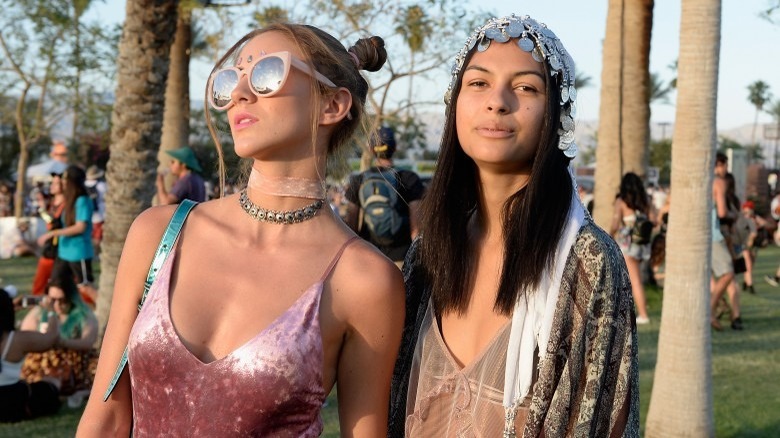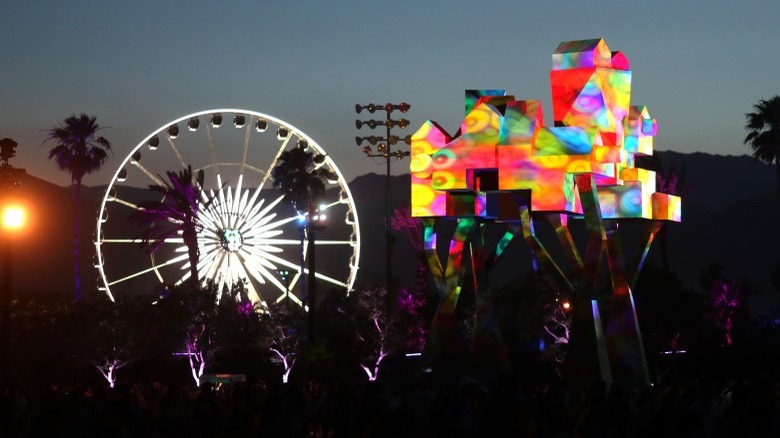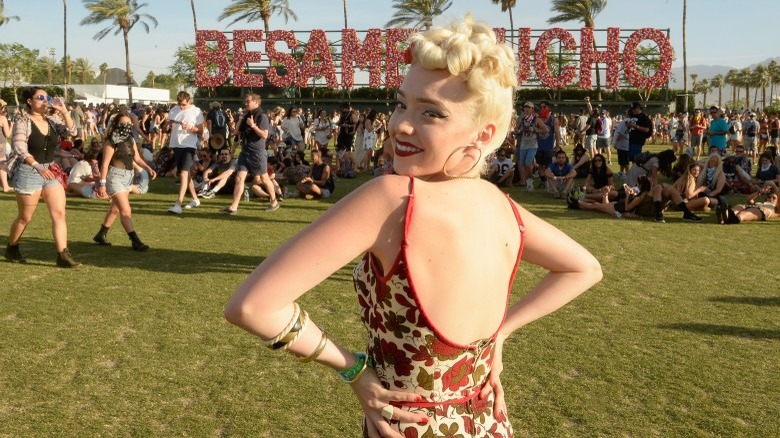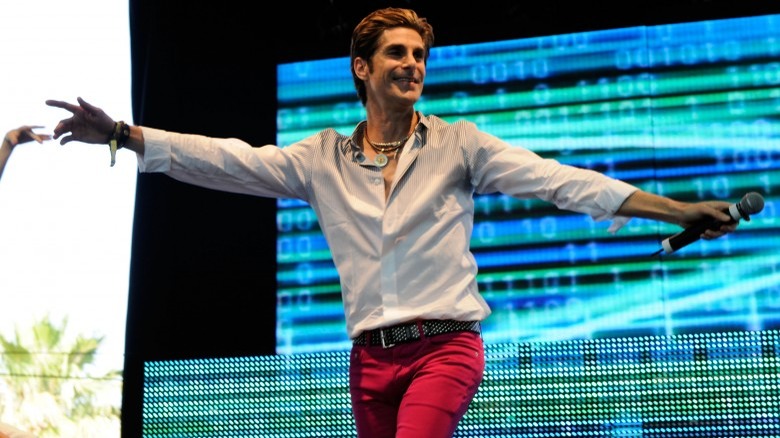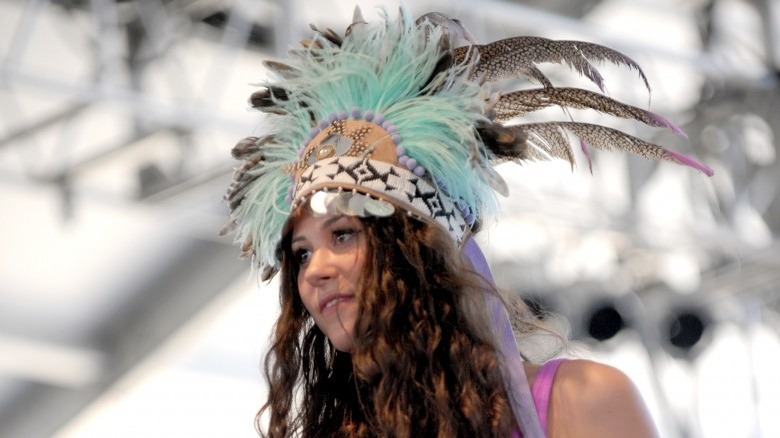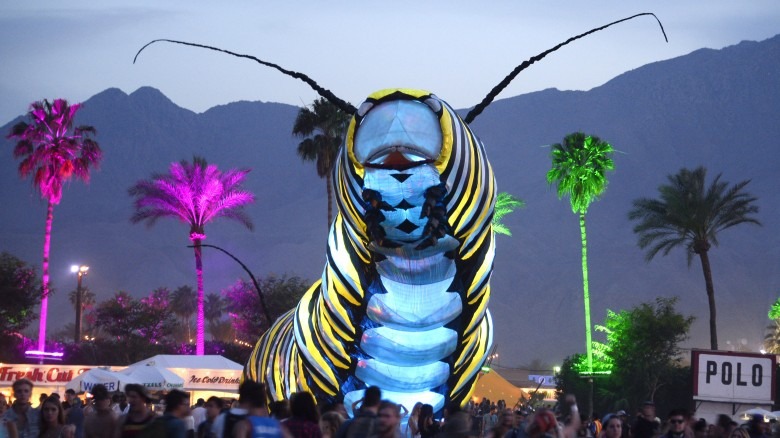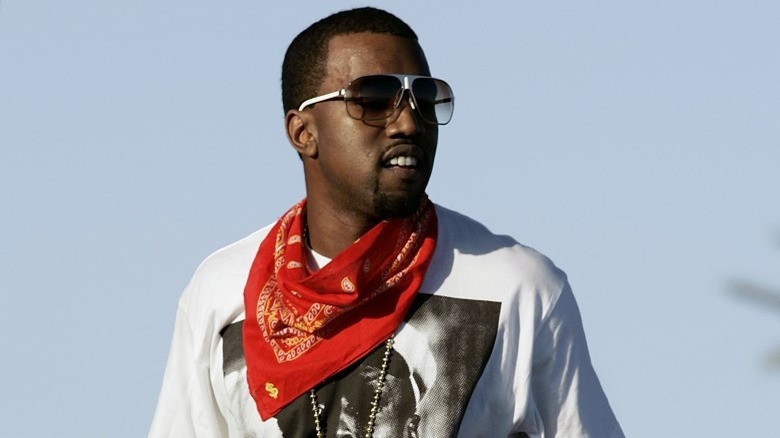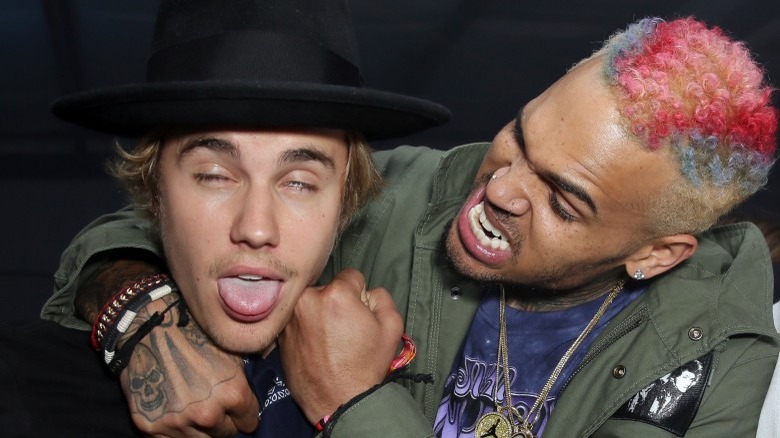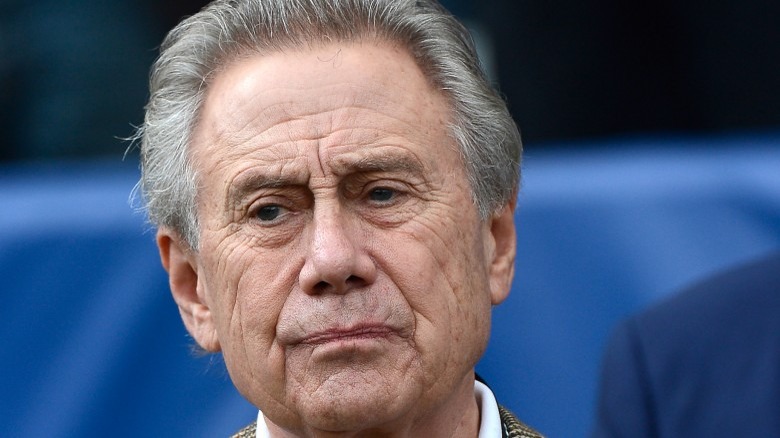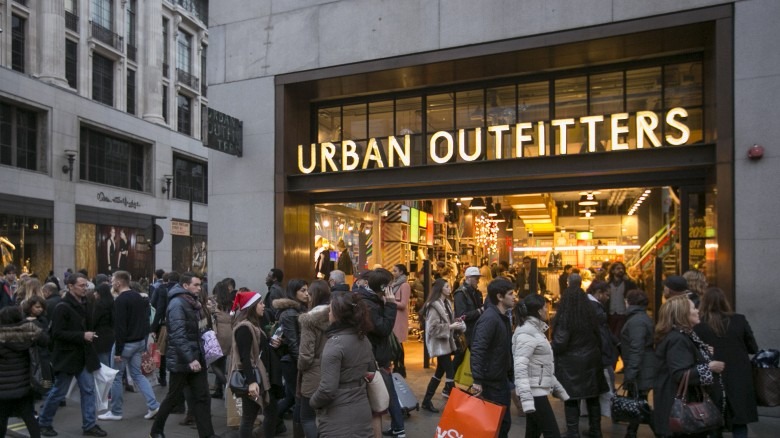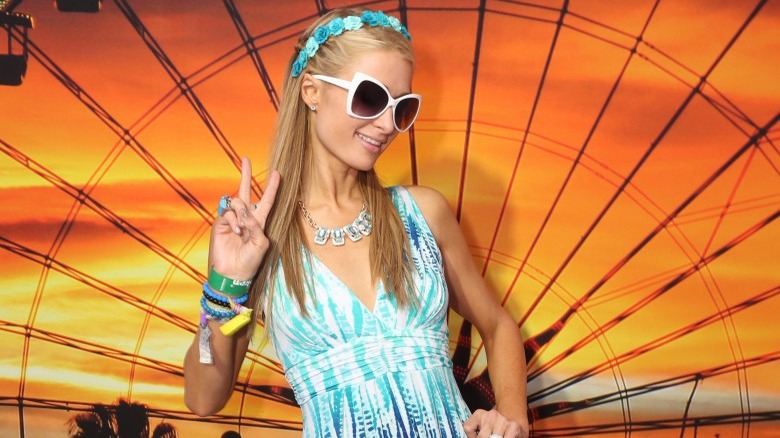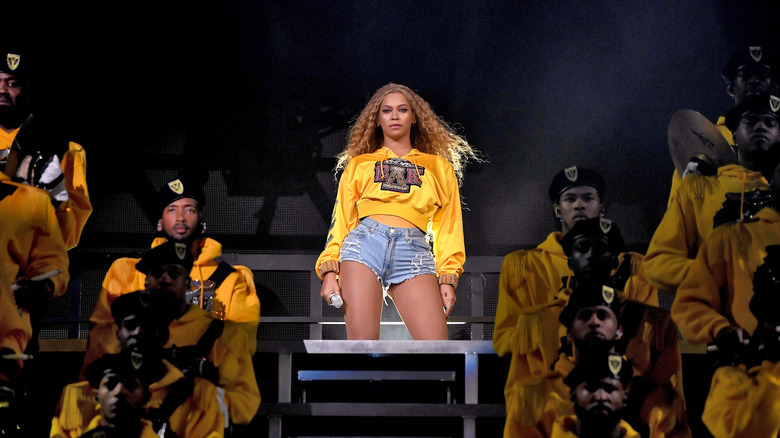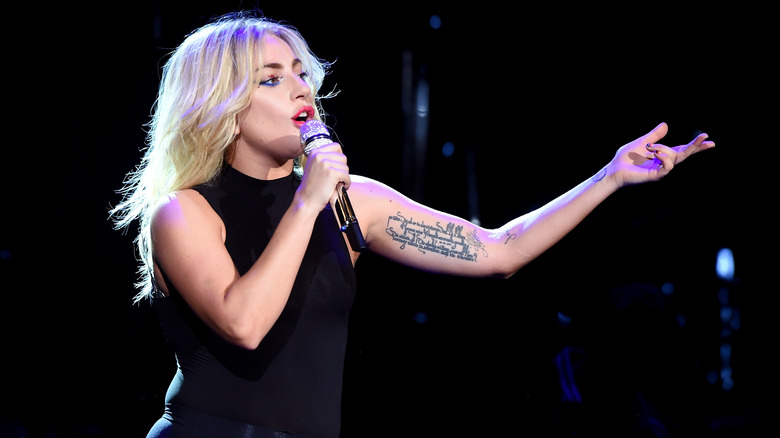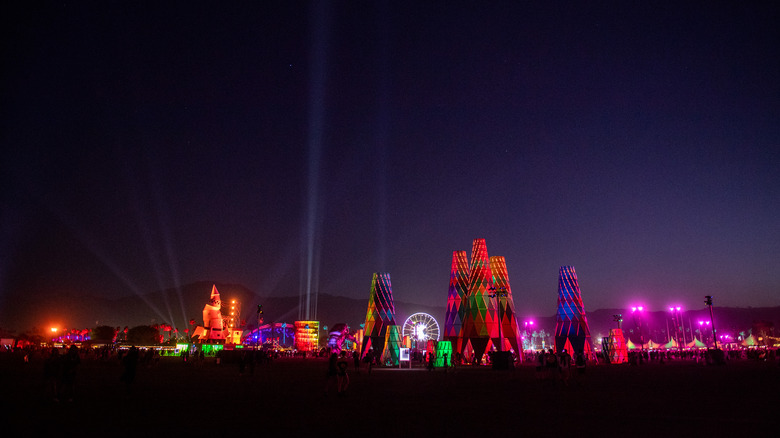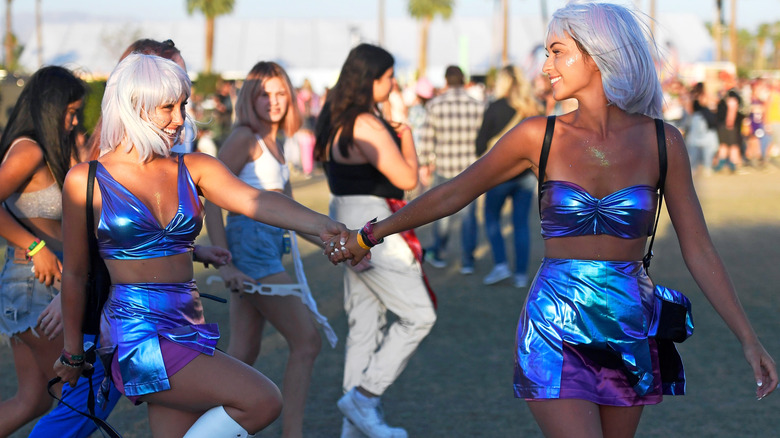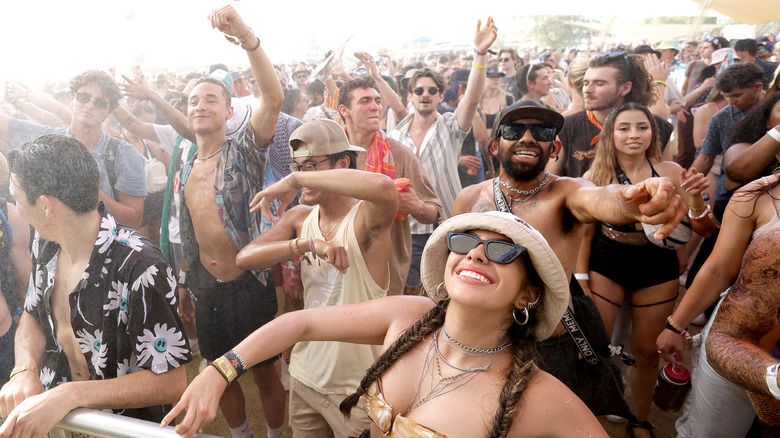The Untold Truth Of Coachella
The Coachella Valley Music and Arts Festival, which takes place at the Empire Polo Club in Indio, California, was first launched back in 1999 by Paul Tollett and, after a short hiatus, it returned to the scene in 2001. Although it was an uphill battle to get the fest off the ground, Coachella has managed to solidify itself as one of the biggest live music events in the world.
In 2015, it earned over $84 million and broke records with 198,000 tickets sold. That was its fourth year as a two-weekend event and it has only continued growing since. In fact, in 2017 the world-famous festival reached a milestone when it grossed more than $100 million for the first time in its history, according to Billboard. Oh, and it sold out in just three hours. But despite Coachella's popularity, iconic performances, and massive following, the fest still holds many secrets.
It all started because of a fight between Pearl Jam and Ticketmaster
It was the grunged-out '90s and Pearl Jam was at the absolute height of its fame when it went head to head with Ticketmaster. Why? Well, because the band was unhappy that the behemoth was gouging the prices of tickets, and unwitting Pearl Jam fans were suffering the consequences. In an attempt to avoid a Ticketmaster-ruled box office, Pearl Jam sought out alternative venues, with minimal ticketing fees.
One of those was the Empire Polo Club in Indio, California, where Coachella is now held, way before it was ever an "it" destination. Despite the area being far from most major cities, the band's "wild and unruly" 1993 show drew a crowd of 25,000, and according to the LA Times, the "really, really big, palm-lined lawn" would never be the same.
Organizers almost pulled the plug after a terrible first year
When it launched in 1999, Coachella lost a whopping $800,000, which forced it to take a step back, skip the following year and reconsider its future. It came back in 2001 with a smaller, one-day show and still didn't manage to rake in a profit. Even so, the festival's promoter, Goldenvoice, and its founder, Paul Tollett (who also just so happens to be the president of Goldenvoice) refused to give up, despite a less than stellar inaugural year and follow-up.
After another year of hard work and dedication, Coachella began solidifying itself as a must-attend festival for music lovers, bringing in major headliners and introducing an on-site camping element that set it apart from the pack. Fast-forward to 2014 and its 579,000 attendance was the largest crowd in the festival's history to that point — and one of the biggest in overall U.S. concert history.
Jane's Addiction's Perry Farrell saved Coachella in 2001
After a less-than-stellar debut in 1999, Coachella took a year off and planned to return to the scene in 2001. The only problem was that festival organizers weren't able to secure a headliner. Enter Jane's Addiction frontman Perry Farrell, who actually played a solo set the inaugural year.
Farrell, who is the founder of Chicago-based music festival Lollapalooza, understood the struggles Coachella founder Gary Tollett was facing first-hand. So he stepped up, offering to help out. Agreeing to reunite Jane's Addiction to headline the one-day fest, Farrell essentially saved Coachella.
From that point on, Farrell has become the one artist who has played Coachella the most times, having appeared on the bill (as both a solo artist, and with various groups) for 10 consecutive years.
It continues to upset many American Indians
Year after year, some Coachella attendees have arrived at the festival grounds wearing traditional American Indian headdresses, and "attire they would never wear elsewhere, like it was a Batman costume or something," as described by Mic.
Rather than banning the appropriated trend (as other North American music festivals, like Osheaga in Montreal, Canada have done), Coachella has continued to allow headdresses on site. And what's more, it has even offered weekend tipi rentals for $2,200.
Why is all of this so insulting? As explained by the Native Appropriations blog, headdresses have "deep spiritual significance" and are not meant to be worn as a fashion accessory. Wearing them "promotes stereotyping of Native cultures" and is "just like wearing blackface," according to many community members.
The festival has an unprecedented $2.2 million yearly art budget
Coachella's full name is the Coachella Valley Music and Arts Festival, and even if many fans may not realize it, the fest sure does live up to the latter part of its name. In addition to the millions of dollars it spends on booking today's biggest musical talent, Coachella has a dedicated $2.2 million budget for public art, which is spent on temporary works created specifically for the event and displayed throughout the festival grounds.
Coachella actually has "one of the largest budgets of large-scale art in the world, at a festival or anything else," according to Tyler Hanson who works for design firm Poetic Kinetics, which has created numerous pieces for Coachella, including 2013's "Helix Poeticus" AKA the Coachella snail. "They have always been commissioning awesome artists to build one-of-a-kind, unique installations," he added. "It's definitely art-for-art's-sake. It's for the kids."
Kanye West's 2006 performance marked an important turning point
From its inception in 1999 up until 2005, Coachella was known for exclusively saving its main stage for rock talent. Come 2006, however, festival organizers threw concertgoers a curveball when they booked Kanye West on the main stage (instead of one of the smaller ones traditionally reserved for hip-hop, EDM and other genres).
Yeezus' performance marked a huge turning point for Coachella. By bringing together one of the biggest crowds of the weekend, the set sparked a more open-minded approach as to which artists could headline the fest. Since that fateful year, everyone from Jay Z, to Kendrick Lamar and Drake have given memorable performances on the main stage.
VIP security is so tight, it sparks major artist drama
Celebrity attendance at Coachella is high every year and VIP security takes no risks in who they do — and do not — admit backstage.
In 2015, Justin Bieber was put in a chokehold and kicked out of the festival when he tried to get in through the artist's entrance during Drake's set. Biebs and his friends were told they couldn't enter because the area was at maximum capacity and that's when the arguing began. After saying he had a personal invite from Drake, a Coachella staffer came to escort Bieber inside which is when security placed the singer in a chokehold and eventually told him to leave the grounds.
Rapper Chanel West Coast (who is signed under the Lil Wayne's Young Money label) had a similar experience in 2017 when she showed up at the VIP entrance with her boyfriend and friend, she was turned away because the latter didn't have the required special wristband. As security guards refused to cave in, despite West Coast's attempt to impress them by dropping Drake's name and referencing Young Money, she had a meltdown, then stormed off.
Coachella's owner has been accused of supporting numerous anti-LGBT groups
Colorado billionaire businessman Philip Anschutz, the founder of Anschutz Entertainment Group (AEG), the company that operates Goldenvoice, has come under fire for allegedly donating substantial amounts of money to three charities with anti-LGBT agendas, including the Alliance Defending Freedom, the National Christian Foundation, and the Family Research Council, as reported by Billboard.
Anschutz has called these claims "fake news," arguing that he would never knowingly do such a thing. "It is all garbage," Anschutz said in a statement. "I unequivocally support the rights of all people without regard to sexual orientation."
"Neither I, nor the Foundation, fund any organization with the purpose or expectation that it would finance anti-LGBTQ initiatives," he added, concluding, "We have immediately ceased all contributions to such groups."
The festival has sued numerous brands for infringement
Festival fashion is a hot topic as the summer kicks off and music lovers get ready to head out to their favorite shows. Retailers know this and try to take full advantage of it in their marketing, but Coachella is having none of it.
In March 2017, they sued Urban Outfitters for "improperly using a number of 'famous' and long-registered Coachella trademarks to sell a number of products" under their Free People label, namely the Coachella Valley Tunic, Coachella Boot, Coachella Mini Dress, and Coachella Pocket Tank. Coachella argued that these items would "deceive consumers" and said they took the case to court only because Urban Outfitters "ignored Plaintiff's demands to cease their unlawful conduct."
Just a few months later, Coachella issued a cease-and-desist order against cannabis brand Lowell Farms for creating a blend it was trying to market directly to festivalgoers. "AEG has demanded Lowell Farms remove any posts tagged #Coachella and to cease using the tag," they explained in a statement, referencing numerous social media posts that linked the fest to the product. Not wanting to "get into a prolonged legal battle with such an established and well funded company," Lowell found the perfect cheeky solution: they renamed their offering #NotChilla.
Coachella's celebrity following is beyond devoted
Not only has Coachella been able to entice countless celebrities to attend its festival, but it has also managed to keep them coming back for more each year. The fest's celeb following is seriously devoted and many of today's biggest A-listers refuse to miss out on the fun, year after year.
Coachella's biggest fan may just be Paris Hilton who has not missed a single year since first experiencing what all the fuss was about back in 2007. Another passionate Coachella attendee is actress Kate Bosworth who has had an ongoing love affair with the fest since 2009. Meanwhile, supermodel Alessandra Ambrosio and "True Blood" star Alexander Skarsgard have made appearance every year since 2010. And, since first attending in 2011, pop superstar Katy Perry has been a Coachella staple as well.
Beyoncé's headlining performance made history
In 2017, Beyoncé was slated to headline Coachella, along with Kendrick Lamar and Radiohead, which would have made her the pop artist to head the festival, as well as one of the only women (via The New York Times). However, after announcing her pregnancy with twins, Beyoncé pulled out of the 2017 festival lineup.
In 2018, though, Coachella festival-goers and those watching at home were in for a treat when Beyoncé finally made it to the main stage. Affectionately nicknamed "Beychella," her set took fans to homecoming at a HBCU (historically Black college and university) with a performance that spanned the artist's career. Not only did Beyoncé make history as the first Black woman to headline the festival, but her performance also became the most-viewed Coachella performance of all time when 458,000 viewers around the world all watched the YouTube stream at the same time, according to Fortune. Booking Beyoncé also marked an important turn for Coachella towards more pop-oriented acts.
Coachella entered the mainstream
As Coachella has grown in popularity, it has also entered the mainstream zeitgeist. Aside from heavily watched live streams, trending performances, and talked about fashion moments, the festival has also made some major pop culture appearances in recent years.
While Beyoncé's now-iconic performance had a massive live audience, Beychella reached new people when the singer released the concert documentary "Homecoming" on Netflix in 2019. The film featured Beyonce's entire Coachella set with clips from both headlining weekends as well as a behind-the-scenes look at her rehearsing and preparing for the show. The documentary was nominated for six Emmy Awards and won a Grammy for Best Music Film.
"Homecoming" wasn't the only time the Coachella festival grounds appeared on film, though. While headlining in 2017, Lady Gaga filmed scenes for "A Star In Born" with her co-star Bradley Cooper between the festival weekends, as the Desert Sun reported. The festival was also featured in an episode of HBO's "Insecure," where the main characters attended Coachella to catch Beyoncé's performance.
There have been complaints of misconduct
The following includes allegations and sexual assault.
The Coachella Valley Music and Arts Festival is one of the biggest festivals in the world, but it's not without its share of issues. In 2018, Teen Vogue writer Vera Papisova shared that she had been "groped 22 times” while she was at Coachella to interview attendees. Papisova spoke with 54 women who all shared that they had experienced sexual harrassement or assualt during the 2018 festival, as well. In response, Coachella organizers launched the Every One program in 2019 to prevent sexual misconduct at the event, according to the Los Angeles Times.
In 2019, there were also allegations of mistreatment from security guards contracted to work at Coachella. These complaints included a lack of sleeping accommodations, food, and bathing areas, according to The Daily Beast. "We know that people who run this have the money," a security guard nicknamed Chowderr told The Daily Beast. "We're not asking for five-star treatment or anything like that. It's just a whole mess."
If you or anyone you know has been a victim of sexual assault, help is available. Visit the Rape, Abuse & Incest National Network website or contact RAINN's National Helpline at 1-800-656-HOPE (4673).
The festival celebrated 20 years
Despite allegations and issues, Coachella Valley Music celebrated its 20th anniversary in 2019. Childish Gambino, Ariana Grande, and Tame Impala headlined the festival that year. To commemorate the special occasion, festival organizers released the YouTube Originals documentary "Coachella: 20 Years in the Desert," which featured archival footage from the music festival's first two decades.
With 20 years' worth of video and more than 2,000 performances, the documentary's filmmakers had to comb through footage to share the one-of-a-kind story of one of the world's most popular music festivals. "I mean obviously there aren't 2,400 performances in the film," producer and director Chris Perkel told Deadline. "But in terms of performances, we felt we needed to communicate the story as we understood it, performances that either captured the essence of a period (like the Rapture in 2003), or were themselves story points critical to understanding the growth of the festival (Madonna in 2006, the Tupac Hologram in 2012, etc.), every one of them made the film."
The documentary debuted in April 2020 on what would have been the first weekend of Coachella, which was postponed and eventually canceled due to the COVID-19 pandemic.
Coachella took a two-year hiatus
When Coachella announced the lineup for its 2020 festival in January of that year, there was little inkling that the festival would be shut down for years. Headliners included Frank Ocean, Travis Scott, and Rage Against the Machine and everything seemed to be going just fine. However, the world looked much different come March 2020, and organizers announced they were rescheduling the year's festival to take place in October because of concerns about the COVID-19 pandemic (via CNN).
In June 2020, Coachella was officially canceled — the first time in 20 years, according to Billboard. Coachella planned to come back in 2021; however, that year's festival was eventually canceled as well. After an unprecedented two-year hiatus, Coachella finally made its comeback in April 2022 with headlining acts Harry Style, Billie Eilish, and Swedish House Mafia with The Weekend, with the latter two acts replacing former headliner Ye. Other performers included Megan Thee Stallion, Doja Cat, and Danny Elfman.

